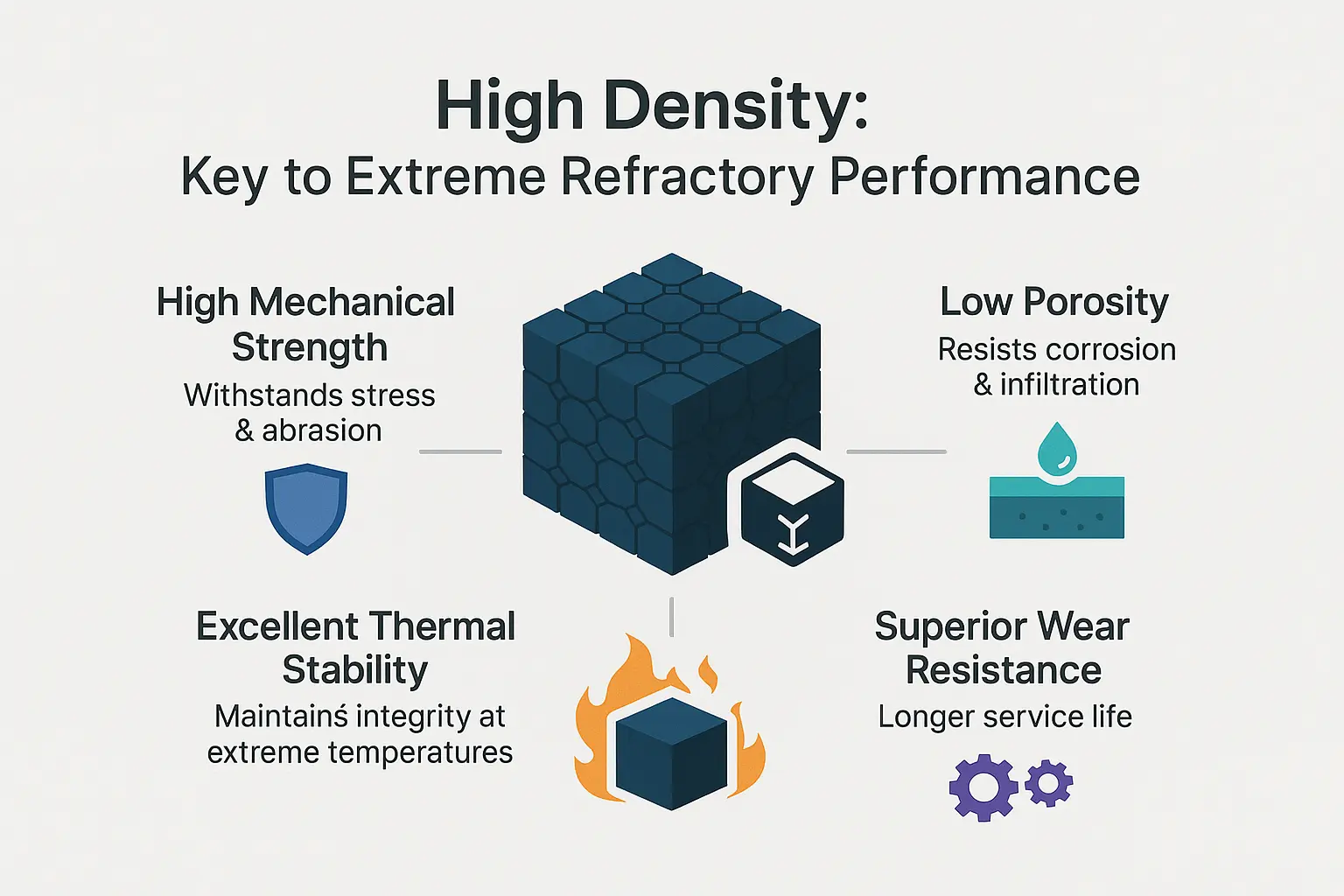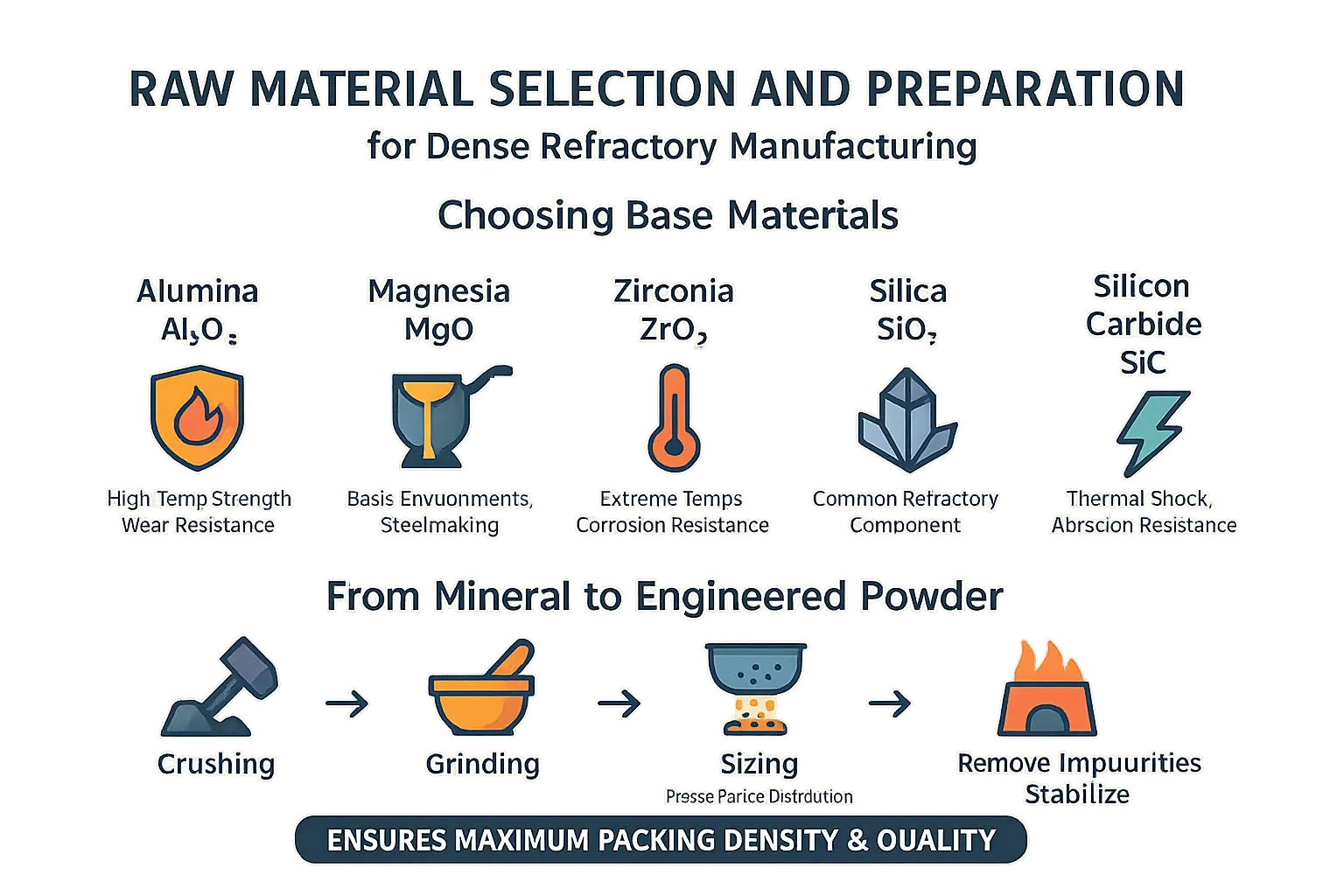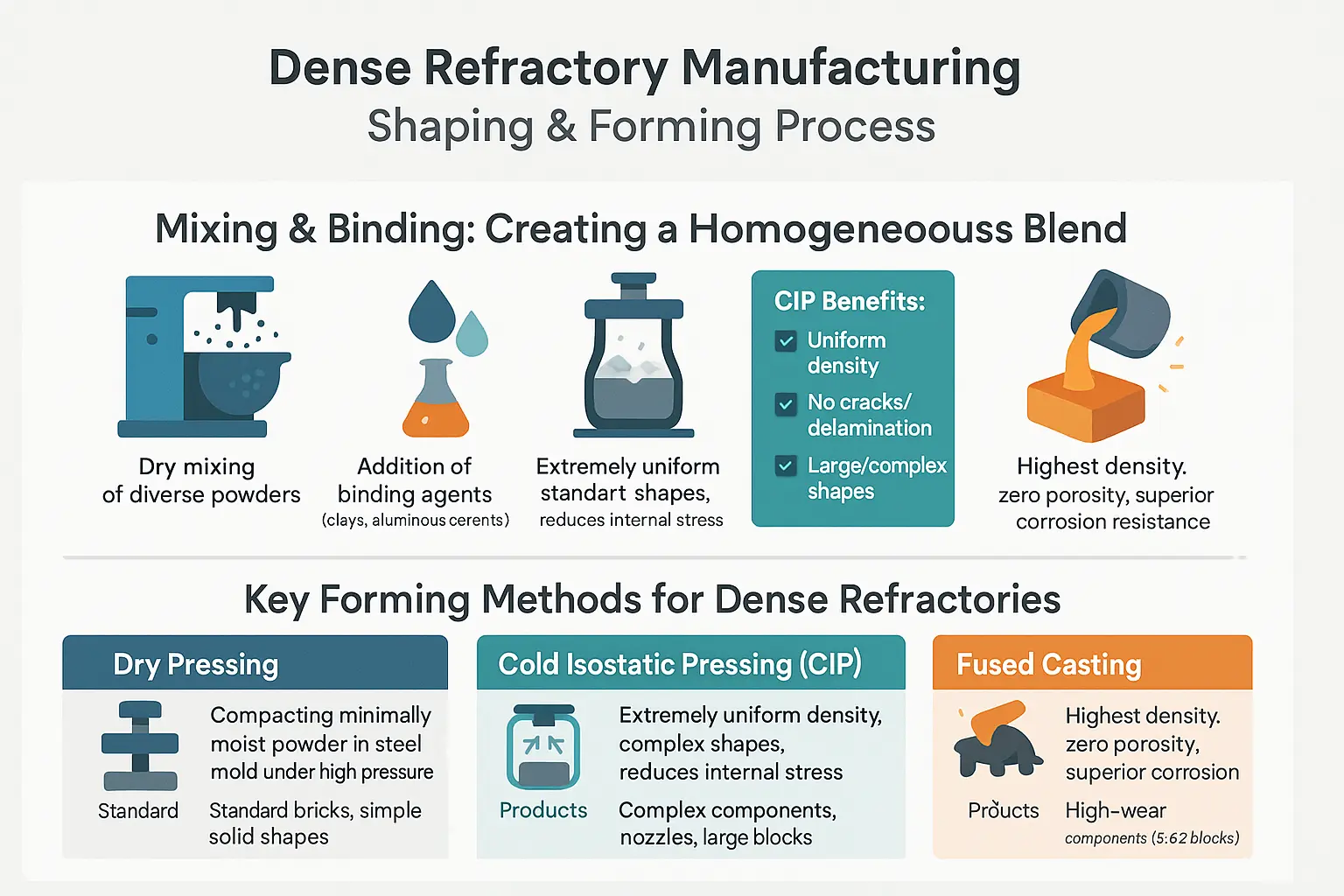Struggling with refractory failures in extreme industrial environments like steel, glass, or cement production? Discover how the dense refractory manufacturing process transforms raw materials into high-performance components engineered for survival. This article reveals the critical techniques—from ultra-precise powder compaction via cold isostatic pressing to advanced fused casting—that achieve unmatched density, zero porosity, and extreme thermal resistance. Learn how these methods combat mechanical stress, chemical corrosion, and thermal shock, ensuring your systems withstand the harshest conditions without compromising safety, efficiency, or operational uptime. Explore the science behind creating materials that outperform in temperatures exceeding 1500°C while maintaining structural integrity through precision drying, sintering, and quality control.
- Why density is the key to extreme refractory performance
- Raw material selection and preparation: the foundation of density
- The core manufacturing process: shaping and forming for maximum density
- High-temperature firing: locking in strength and performance
- Challenges and innovations in dense refractory manufacturing
- Partnering for Optimal Refractory Performance

Why density is the key to extreme refractory performance
Refractory materials must endure punishing environments, yet dense refractory products achieve this through calculated engineering. Dense refractory products are specifically designed to maximize high density while minimizing low porosity – a critical balance for industrial applications. These materials form the backbone of furnaces, kilns, and reactors where temperatures exceed 1,500°C and chemical aggression threatens structural integrity.
- High mechanical strength: withstands physical stress and abrasion in steelmaking ladles and cement kilns
- Low porosity: resists chemical corrosion from molten slag and aggressive gases
- Excellent thermal stability: maintains dimensional consistency under extreme thermal cycling
- Superior wear resistance: extends service life in glass furnace superstructures
The engineering of these properties begins with raw material selection. High-purity alumina, zirconia, and silicon carbide create dense microstructures through controlled particle packing. During isostatic pressing at 150-600 MPa, particles are compacted to reduce voids below 15% porosity. Subsequent firing at 1,600°C sinters the material, creating interlocking crystalline bonds that enhance load-bearing capacity.This dense refractory manufacturing process directly addresses industrial failure modes. For instance, in basic oxygen furnaces, low-porosity magnesia-carbon bricks resist steel slag penetration through reduced capillary action in pores smaller than 1μm. Similarly, silicon carbide-based dense refractories in aluminum holding furnaces maintain thermal conductivity while resisting alkali metal vapor infiltration.How does this translate to real-world performance? The answer lies in the precise control of density parameters during production. What specific steps transform raw materials into these extreme-environment materials? The manufacturing sequence holds the key to this transformation.

Raw material selection and preparation: the foundation of density
Choosing the right base materials
Why does a material survive 1,800°C in steelmaking while another fails at 1,500°C? The answer lies in raw material selection. Dense refractories begin with precise chemical choices: alumina (Al₂O₃) for high-temperature strength, magnesia (MgO) in basic steelmaking environments, zirconia (ZrO₂) for extreme corrosion resistance, and silica (SiO₂) as a common matrix component. Silicon carbide (SiC) adds thermal shock resistance. For specialized applications like glass furnace linings, high-alumina refractories dominate due to their exceptional fusion resistance.
- Alumina (Al₂O₃): For high-temperature strength and wear resistance
- Magnesia (MgO): Used in basic environments, common in steelmaking
- Zirconia (ZrO₂): For extremely high temperatures and excellent corrosion resistance
- Silica (SiO₂): A common component in many refractory formulations
- Silicon Carbide (SiC): For exceptional thermal shock resistance and abrasion resistance
From raw mineral to engineered powder
How do raw minerals become precision-engineered powders? The transformation involves three critical steps. First, crushing reduces bauxite or dolomite chunks to manageable sizes. Then grinding in high-energy ball mills creates micrometer-scale particles. Finally, sizing separates particles through vibrating screens, ensuring optimal granulometric distribution. This isn’t just processing – it’s quality control. Without precise particle arrangement, achieving maximum packing density would be impossible. Advanced software like ParSD now optimizes particle size distribution by modeling Andreasen or Dinger/Funk curves, guaranteeing ideal packing density before forming even begins.
Calcination completes the preparation. At temperatures up to 1,850°C, this step removes volatile impurities and initiates sintering. For magnesite, calcination transforms MgCO₃ into MgO while shedding 50% of its weight. This early-stage processing determines final product stability – uncalcined materials risk dimensional instability and cracking during later firing. The calcination process varies by material: bauxite requires 1350-1550°C with 15% weight loss, while dolomite needs 1650-1850°C for CaO°MgO formation. These precise thermal treatments stabilize materials before shaping, preventing catastrophic failures in extreme environments.
This preparation creates engineered powders with controlled reactivity, setting the stage for high-pressure forming and ultra-dense microstructures. Even minor variations in particle size distribution or calcination temperature can dramatically affect final product performance. Proper preparation ensures optimal packing density, which directly correlates with mechanical strength and thermal shock resistance in the finished refractory product.

The core manufacturing process: shaping and forming for maximum density
Mixing and binding: creating a homogeneous blend
Creating a homogeneous blend starts with precisely combining raw materials like calcined alumina, zirconia, and silicon carbide in industrial mixers. Particle sizes are carefully selected to optimize packing density. Advanced mixers with variable-speed agitators and heating/cooling capabilities ensure complete homogenization.
Binding agents like bentonite clay (2% typical) or calcium aluminate cement play dual roles: enhancing plasticity during forming and providing green strength pre-firing. Chemical additives such as BYK rheology modifiers improve flow characteristics, while defoamers like BYK-012 eliminate air bubbles. This critical blending stage ensures uniform material distribution before forming. The process requires 15-30 minutes of mixing to achieve homogeneity, with temperature control between 20-40°C to maintain material integrity.
Forming techniques: from powder to solid shape
| Forming Method | Description | Key Advantage | Typical Products |
|---|---|---|---|
| Dry Pressing | Compacting minimally moist powder (8% water content) in steel molds under 250-500 psi pressure | Cost-effective for standard shapes | Standard bricks, simple blocks |
| Cold Isostatic Pressing (CIP) | Applying 10,000-40,000 psi hydrostatic pressure to powder in flexible molds using water or oil as pressure medium | Uniform density for complex geometries | Large blocks, nozzles |
| Fused Casting | Melting raw materials at 1900-2500°C then casting molten material into molds with controlled cooling | Near-zero porosity construction | AZS blocks for glass furnaces |
Cold Isostatic Pressing (CIP) achieves remarkable compaction through liquid pressure transmission. Two systems exist: wet bag (powder-filled mold submerged in pressurized water/oil) and dry bag (separate pressure chamber). This process delivers:
- Uniform density throughout the component
- Elimination of cracks and delamination
- Production of large/complex shapes
- Reduced internal stress for better stability
Fused casting creates fused-cast refractories through electric arc furnace melting at temperatures exceeding 2000°C. The molten material is poured into molds where controlled cooling forms dense microstructures with less than 1% apparent porosity. Special techniques like Void Free (VF) casting minimize shrinkage cavities, while End Cut (ENC) methods remove most defects for critical applications.
Drying: the critical intermediate step
Green bodies undergo controlled drying at 110°C for 48 hours to remove mixing water. This gradual process prevents dimensional instability by avoiding moisture gradients between surface and core. Rapid drying causes differential shrinkage, leading to warping or cracking that compromises structural integrity. The drying process follows three distinct phases: constant rate period, falling rate period, and equilibrium stage.
Particularly for water-based mixtures, humidity and airflow must be precisely managed. Improper drying creates hidden weaknesses that manifest during firing, potentially causing catastrophic failure in high-stress applications. Advanced drying systems use staged temperature increases (25°C to 110°C over 24 hours) to ensure complete water removal while maintaining shape fidelity. The drying environment typically maintains 60-70% relative humidity during early stages to prevent rapid surface drying that could trap moisture internally.
Quality control during drying is essential. Moisture content is monitored using microwave resonance technology to ensure levels drop below 0.5% before firing. Special attention is given to thick-walled components where moisture migration can take significantly longer. Automated control systems adjust temperature and airflow based on real-time moisture readings from embedded sensors.
High-temperature firing: locking in strength and performance
The science of sintering
At the heart of refractory production lies sintering, a critical process where compacted raw materials undergo high-temperature treatment (often exceeding 1500°C). During this phase, atomic diffusion at particle contact points causes neck formation between grains, eliminating residual pores and achieving densification levels from 50% porosity to as low as 0.2%. This transformation creates robust ceramic bonds that determine the material’s fire resistance and chemical stability.
The sintering mechanism operates through solid-state diffusion, where atoms migrate across grain boundaries under heat. While solid-state sintering maintains materials in their original phase, liquid-phase sintering introduces additives that melt first, enabling capillary action and subsequent solution-precipitation processes. These mechanisms enhance densification and grain growth, crucial for applications facing thermal cycling. The resulting microstructure directly influences properties like mechanical strength, with proper sintering increasing cold crushing strength values by over 300% in some alumina-based materials.
Kiln technology for refractory production
Modern refractory manufacturing relies on three primary kiln systems: tunnel kilns for continuous production, shuttle kilns for specialized shapes, and periodic kilns for large-scale components. Tunnel kilns handle 80% of formed refractories through staged heating zones, maintaining precise temperature gradients (55–380°C/h) to prevent thermal stress. Shuttle kilns offer flexibility for custom geometries, while periodic kilns accommodate oversized pieces exceeding 10 tons.
Process control remains paramount: ASTM C865 standards dictate maximum heating rates (e.g., 390°C/h above 815°C) and oxygen-rich atmospheres (>0.5% O₂) to ensure structural integrity. Advanced systems employ platinum-rhodium thermocouples for ±2°C accuracy during soaking periods. This precision creates optimal microstructures, directly impacting thermal shock resistance—a critical factor where materials like silicon carbide demonstrate 50% higher resistance through controlled pore distribution.
Final processing and quality control
Post-firing operations include diamond tooling for dimensional accuracy, particularly for fused-cast components requiring tolerances within ±0.05mm. Quality assurance follows rigorous protocols: ASTM C20 measures apparent porosity and bulk density, while ASTM C133 evaluates cold crushing strength (up to 250 MPa in high-alumina bricks). Dimensional checks using laser profilometers ensure compliance with ISO 5022 standards for refractory shapes.
Thermal performance validation involves ASTM C832 tests for thermal expansion under load, where materials like magnesia-carbon refractories must withstand 0.75% creep at 1500°C over 10 hours. Non-destructive testing via ultrasonic pulse velocity identifies internal defects before final inspection. Only products passing these 12+ quality checkpoints—covering physical, mechanical, and thermal properties—proceed to packaging, ensuring every unit matches MXS Refractories’ performance guarantees for glass, steel, and cement industry applications.
Challenges and innovations in dense refractory manufacturing
Overcoming manufacturing defects
Producing dense refractory products demands precision to avoid defects that compromise performance. Even minor flaws like drying cracks or non-uniform porosity can lead to catastrophic failures in extreme environments. For instance, oversized or irregularly shaped aggregates in raw materials create internal stress points, while improper drying schedules trap moisture, expanding into steam during firing and causing microfractures. In cement kilns, such defects reduce lining lifespan by 40%, increasing maintenance costs.
Complex geometries exacerbate these issues. Large-format refractories often develop thermal gradients during heating, where outer layers expand faster than inner cores, inducing cracks. Similarly, uneven pressure distribution in dry-pressing methods leads to density variations, reducing mechanical strength. These challenges directly impact industries like steelmaking, where a single defective component might halt production worth $50,000 per hour. Advanced monitoring systems now track moisture levels in real-time, ensuring optimal drying rates and minimizing defects.
The future of refractory production
Innovations are transforming defect prevention. Cold isostatic pressing (CIP) now ensures uniform pressure application, achieving 98% theoretical density in critical components. This method applies 400 MPa of hydrostatic pressure, ideal for complex shapes in glass furnace linings. Advanced chemical binders, such as alkali-activated silicates, eliminate high-temperature curing steps, cutting energy use by 30% while maintaining structural integrity at 1,800°C. These binders also reduce emissions by 20% during production.
Digital tools enhance precision. Computational modeling predicts material behavior during firing, optimizing kiln cycles to minimize thermal stress. For sustainability, manufacturers integrate recycled magnesia-carbon aggregates from spent ladle linings, reducing raw material extraction by 25% without sacrificing corrosion resistance. These advancements address 80% of traditional failure modes, according to recent industry trials, while aligning with circular economy goals.
Emerging additive manufacturing techniques now enable complex geometries previously unachievable through conventional pressing. By layering refractory powders with reactive binders, companies produce components with tailored porosity patterns, improving thermal shock resistance in glass furnace applications. For example, 3D-printed nozzles with graded porosity show 30% higher spallation resistance, revolutionizing custom component design.
Partnering for Optimal Refractory Performance
Producing dense refractory products demands precision across all stages, from raw material selection to high-temperature firing. Each step ensures materials withstand extreme environments, maintaining structural integrity under thermal, chemical, and mechanical stress. For industries like glass, steel, and cement, material quality directly impacts operational efficiency and safety.
Raw material purity, uniform particle distribution, and advanced binding agents form the foundation of durable refractories. High-temperature firing creates robust ceramic bonds, while precise shaping ensures dimensional accuracy. These steps collectively enable products to resist corrosion, abrasion, and thermal shock—critical for applications exceeding 1,800°C.
Mastering this process requires expertise. MXS Refractories specializes in guiding industrial leaders through material selection and on-site supervision. Their approach ensures refractories are engineered for specific challenges, minimizing risks like spalling or structural failure.
Choosing the right manufacturing process is just one aspect. Understanding the complete lifecycle of refractory materials, including installation and maintenance, ensures long-term performance. MXS provides end-to-end support, combining technical knowledge with field experience to optimize durability and reduce downtime.
Partnering with experts helps industries avoid costly failures—preventing losses exceeding $1 million daily. MXS’s quality control ensures materials meet rigorous standards, transforming refractory systems into resilient assets in extreme conditions.
Understanding the complete lifecycle of refractory materials shows how strategic partnerships ensure precision manufacturing and expert oversight in extreme environments.
The dense refractory manufacturing process combines precise raw material selection, advanced forming techniques, and high-temperature firing to achieve unmatched density, mechanical strength, and thermal stability. These properties ensure reliability in extreme industrial environments. Partnering with experts like MXS Refractories guarantees tailored, high-performance solutions designed to meet demanding operational challenges. Explore [understanding the complete lifecycle of refractory materials](https://mxs-refractories.com/understanding-the-lifecycle-of-refractory-materials/) for optimized performance.
